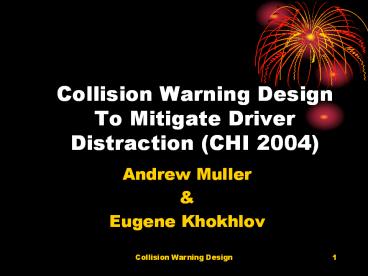Collision Warning Design To Mitigate Driver Distraction (CHI 2004) PowerPoint PPT Presentation
1 / 29
Title: Collision Warning Design To Mitigate Driver Distraction (CHI 2004)
1
Collision Warning DesignTo Mitigate Driver
Distraction (CHI 2004)
- Andrew Muller
- Eugene Khokhlov
2
University of Iowa
- Elizabeth
- Hayes
- Daimler Chrysler
- (Chewbacca)
- Joshua
- D. Hoffman
- Grad Student
- John D. Lee
- Ph.D.
3
To The Point
- The Problem Too many distractions while driving
a car - The Need Collision warning system
4
Background Information
- In-vehicle Information Systems (IVIS) are now
feasible because - Technology Advances
- Societal Trends
- IVIS Functionality
- Response Types
- Critical Factors for IVIS
5
Alert Strategies
- Warning Strategies
- Graded
- Single Staged
- Sensor Modality Presentation
- Haptic (touch)
- Auditory
6
Experiment Goals
- Experiment 1
- Examine how driver response depends on graded and
single stage warnings - Examine how driver response depends on modality
(haptic vs. auditory) of the warning - Experiment 2
- Examine how these warning strategies and
modalities affect driver preference
7
Experiment 1 Method
- A mixed between/within-subject experimental
design - 3, 15-minute driving scenarios
- 21 braking events (7x3)21
- 3 levels of severity
- Speech-based email system to distract the driver
8
Participants
- 40 individuals
- 20 female, 20 male
- Ages of 25 and 55 (licensed)
- Unaware of the nature of the research
- Paid 20 each
9
Apparatus
- Fixed-based, medium-fidelity driving simulator
- 1992 Mercury Sable
- 50-degree visual field of view
- 640x480 screen
- Visual collision warning icon
- Needed elements for auditory and haptic alerts
10
DriveSafety (Hyperion)
11
Experimental Design and Independent Variables
- Mixed between-within subject design
- Between subject variables
- Warning modality
- Warning strategy
- Within subject variables
- Severity of lead vehicle breaking
- If response was require
12
Dependent Variables
- Safety benefit
- Number of collisions
- Adjusted minimum time to collision (AMTTC)
- Driver response process (response followed by
assessment or assessment followed by response)
13
Procedure
- Operation instruction
- Introductory drive (5 min)
- 3 main drives (15 min/each)
- 7 braking events per drive
- _at_ 55mph
- 1/7 was severe, always at end
- Complete auditory email task
14
Results
- 741 data points total
- Repeated-measures ANOVA was used to analyze the
data using two-tailed hypothesis tests
15
Results Severity of braking events and driver
response
- Drivers responded to braking events in a
systematic and realistic manner - AMTTC reflected braking severity
- Severity of lead vehicle braking affected
drivers braking response - Severity of braking affected mean deceleration
16
Results Interface characteristics and safety
benefit (collisions)
- 40 potential collisions
- 10 collisions occurred
- 7 in single-stage and 3 in graded
- X2(1) 2.13, p0.144
- 5 in auditory and 5 in haptic
17
Results Interface characteristics and safety
benefit (AMTTC)
- Slight benefit for graded compared to
single-stage - F(1,36)8.74, p0.0055
- Graded substantially better in severe braking
events
18
AMTTC
19
Response to nuisance alarm braking events
20
Experiment 2 Method
- A within-subject experimental design
- 4, 10-minute scenarios
- 24 braking events
- 3 levels of severity
- 2/3 of events required no driver response
21
Participants
- 20 individuals
- 11 females, 9 males (licensed)
- Between the ages of 25 and 55
- Unaware of the nature of the research
- Paid 20 each
22
Apparatus Independent variables and
experimental design
- Same as in experiment 1
23
Dependent variables
- Driver attitudes were measured with a series of
subjective rating scales after each drive - After completion of all trials, they
comparatively ranked the systems
24
Procedure
- Operation instruction
- Introductory drive (5 min)
- 4 main drives (10 min/each)
- 6 braking events per drive
- Each scenario had an equal number of event
severity
25
Results
- Rank the warning modalities in order from 1 to 4
based on preference - Violation of assumption of a repeated measures
ANOVA - Applied Friedmans non-parametric analysis
- Only when Friedmans showed a significant
difference between conditions was a post-hoc
multiple comparison performed using Fishers
least significant difference method
26
(No Transcript)
27
Conclusions
- Graded warning provided a greater safety margin
- Graded warning induced fewer inappropriate
responses to the nuisance alarms - Graded warning was more trusted
- Warning modality had little effect on performance
in severe braking events - Haptic warnings were preferred on several
dimensions to auditory
28
Questions
- In table 2, graded haptic beats single-stage
haptic in everything except overall preference,
what can account for this? - Does the data on table 2 match what you would
have expected? - Graded is preferred for a one hour experiment,
how about 5-10 years on daily basis?
29
Questions
- Haptic is preferred over auditory in this study,
is this a property of auditory or a property of
the time span of the test, or some other factor? - Why express haptic through a seat and not a gas
pedal as in previous studies?

